Jack Teagarden Part I:
The Filmed Instrumentals
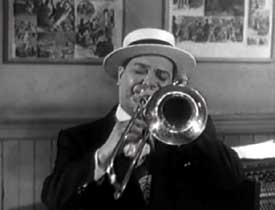 All Jack Teagarden's Snader telescription bill his small band as "Jack Teagarden & His All Star Group," though it's elsewhere called "Jack Teagarden & His All-Stars" or "Jack Teagarden & His Sextet," though counting Jack it's a Septet. All Jack Teagarden's Snader telescription bill his small band as "Jack Teagarden & His All Star Group," though it's elsewhere called "Jack Teagarden & His All-Stars" or "Jack Teagarden & His Sextet," though counting Jack it's a Septet.
Lover (1952) is a slightly toned down, rag-timey Dixieland piece, with Jack's trumbone solo dominating. The number bounces along charmingly enough though it is nothing special.
The boys are wearing straw hats, as they do in only two of their ten telescriptions. The staging arranges them to seem to be crowded together in a small club or bar.
There are several camera angels provided, so we see the paintings on the walls, the tables & chairs in the background of one shot, the bar & bottles in another shot, but there's no bartender, no customers, the band is playing to an empty house.
The dates I've given them are the ones that appear on the original title cards, some 1951, some 1952. But the dates represent release copyright; they were all filmed in 1951, probably in only two days, with minimal costume changes & even few set alterations between films.
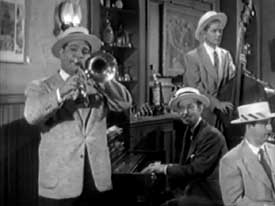 The straw hats are still on for Wolverine Blues (1952), again staged in the bar/club. The hats are again a give-away that it's a Dixieland number.
The straw hats are still on for Wolverine Blues (1952), again staged in the bar/club. The hats are again a give-away that it's a Dixieland number.
The whole band does Dixieland exceptionally well, without the camp ingredient one gets from, say, the Firehouse Five Plus Two.
However, all too often these jaunty Dixieland pieces seem interchangeable band to band, & that's true for Teagarden's last little band as well.
The band members changed over the decade, but here we see (with one exception) the very first & original Jack Teagarden's All-Stars, drawn together in 1951. The exception is lack of clarinetist Matty Matlock who sat in on the septet's very first recording session but then didn't become part of the touring group or the guys seen in the telescript films.
The members we are seeing in all the telescriptions are drummer Ray Bauduc, bass player Ray Leatherwood, pianist Marvin Ash, clarinetist Don Bonnee, two saxophonists Pud Brown tenor & Heinie Beau alto, trumpeter Charlie "Little Tea" Teagarden, & Jack himself on slide trumbone.
Jack & his trumpting younger brother tend to dominate, but this particular number lets a couple others in the band shine too. We get an upright piano solo from Marvin, & he is unusually brilliant. This is followed by a sax solo from Heinie, then Charlie's trumpet.
To a junglish drum beat & Jack's prefacing trumbone solo, Dark Eyes (1952) builds momentum & turns into a Dixieland arrangement, with a round of solos for most of the musicians, upright piano with the inner workings showing, alto sax, trumpet, clarinet, before Teagarden's trumbone brings it home.
The second sax (Pud Brown) & the slap base (Ray Leatherwood) never do get a solo in any of the Snaders, & drummer Ray Bauduc only rarely does. But for Dark Eyes Bauduc does have shining moments.
Jack first recorded this song in 1941 with his big orchestra, but this slimmed down arrangement a decade later is a more pleasing.
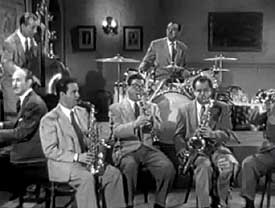 Although Jack's All Stars didn't keep the straw hats on for That's A Plenty (1951), this is another pure Dixieland toe-tapper, rather hoary & circusy, but too good to complain about it.
Although Jack's All Stars didn't keep the straw hats on for That's A Plenty (1951), this is another pure Dixieland toe-tapper, rather hoary & circusy, but too good to complain about it.
Jack as usual highlights his own trumbone playing, with only brief solos for piano & sax, then trumpet & clarinet, before the trumbone takes over anew.
The rest of the septet's telescriptions would explore other sounds of the era, or Jack's vocals, as they were by no means a Dixieland band per se. Not all the telescriptiosn are Dixieland by any means, though the sound of New Orleans, & of Louis Armstrong in particular, informs much of the septet's music.
The most purely Dixieland instrumentals are my least favorite among the telescriptions, though that's strictly a matter of taste & these guys do Dixieland better than many a band that did nothing else. My favorites are the ones on which Jack sings, which I review in the second page of this overview.
Lover, Wolverine Blues, Jack Armstrong Blues & That's A Plenty were drawn straight from the Teagarden septet's very first record session after Jack left Louis Armstrong's All-Stars. The telescriptions, being live-filmed performances rather than mime to recordings as was the case with soundies, these versions are distinct from the tracks they'd shortly before laid down for their first LP release in 1951, ten cuts issued as Unforgettable.
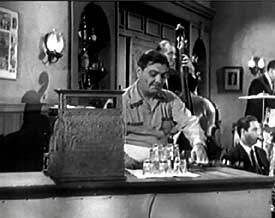 Jack Armstrong Blues (1951) shares a title with a very different 1944 composition.
Jack Armstrong Blues (1951) shares a title with a very different 1944 composition.
The production on this little film explores the by-now familiar tavern/club stage a little more than average. Teagarden is no longer in a suit & is really looking like a working class stiff behind the bar, wearing a white apron. So perhaps all along he was the bartender & that's why we never see anyone else tending that bar in a club empty of anyone but the band.
Jack comes out from behind the bar with his trumbone & begins playing a muted lead that is just so down Harlem way, to which one could be truckin', shufflin', or stompin'. He then returns to duties behind the bar as solos trade off from Marvin Ash's piano to Heinie Beau's alto sax to Charlie Teagarden's trumpet to Don Bonnee's clarinet.
It's then back to Jack, playing his trumbone while behind the bar. A drum solo from Ray Bauduc will soon follow, & he is one helluva drummer, having had his own orchestra in the 1940s. Though I always prefer it when Jack sings, of the instrumental Snaders, this is the best one.
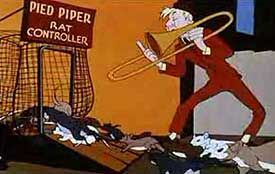 The Walter Lantz "Swing Symphony" technicolor cartoon The Pied Piper of Basin Street (1945) features the trumbone stylings of Jack Teagarden.
The Walter Lantz "Swing Symphony" technicolor cartoon The Pied Piper of Basin Street (1945) features the trumbone stylings of Jack Teagarden.
The tale opens on a business street, with the rats running rampant through the town. The mayor (a poor caricature of Lou Costello) is besieged with phone calls from citizens & business owners insisting he get rid of the rats.
A skinny bucktooth dude with voice imitating Jimmy Durante introduces himself to the mayor as the Pied Piper, & pulls out a trumbone.
He promises, "For a small financial re-im-bois-ment, I'll run every rat out of this town." The sound of Jack Teagarden's trumbone brings all the rats running. One of them exclaims, "Solid, Jackson! That guys from Basin Street!"
He's soon caged all the rats, but the mayor pays him with a bag of peanuts. "That's humilly-atin'. I won't work for peanuts!"
Abused & thrown out of city hall, revenge is in the offing. In response to being cheated, the Pied Trumbonist makes his ears bigger & turns into his alternate identity, Hank Swoonatra.
He sings in a Sinatraesque manner: "Love came but once to me/ All others fled..." This brings all the girls into the streets screaming with love, & all the teenage boys with admiration.
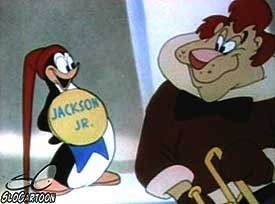 Then with more Teagarden horn, he leads all the town's teenagers to the Swing Ship where they'll hear 100 name bands (including the sign promises Ozzie Nelson, Harry James, Jack Teagarden, & Glenn Miller). Then with more Teagarden horn, he leads all the town's teenagers to the Swing Ship where they'll hear 100 name bands (including the sign promises Ozzie Nelson, Harry James, Jack Teagarden, & Glenn Miller).
Just before the ship sales away into the night upon a perpetual swing voyage, the rats are let out of their cage to run reign over the town forevermore.
Another Walter Lantz "Swing Symphony" cartoon Sliphorn King of Polaroo (1945) has such drunken content that it hardly seems suited to child viewing, but for adults fond of vintage animation, it's a delight.
It's the tale of a trombone playing lion by the name of Jackson who falls off the side of a ship & becomes castaway on the frigid isle of Polaroo. He would have frozen to death but by playing hot jazz he keeps warm.
The narrator of the tale is Hans Conreid. Jackson's trumbone music is provided by Jack Teagarden, whose entire orchestra can be heard on the soundtrack. The inhabitants of Polaroo sing an amazing little number "Jackson the Sliphorn King of Polaroo" with vocals provided by Jack Teagarden & baritone Lee Sweetland.
copyright © by Paghat the Ratgirl
|
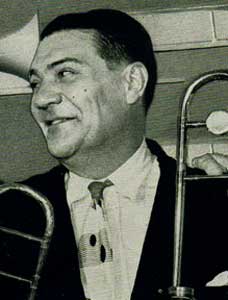





 Then with more Teagarden horn, he leads all the town's teenagers to the Swing Ship where they'll hear 100 name bands (including the sign promises Ozzie Nelson, Harry James, Jack Teagarden, & Glenn Miller).
Then with more Teagarden horn, he leads all the town's teenagers to the Swing Ship where they'll hear 100 name bands (including the sign promises Ozzie Nelson, Harry James, Jack Teagarden, & Glenn Miller).